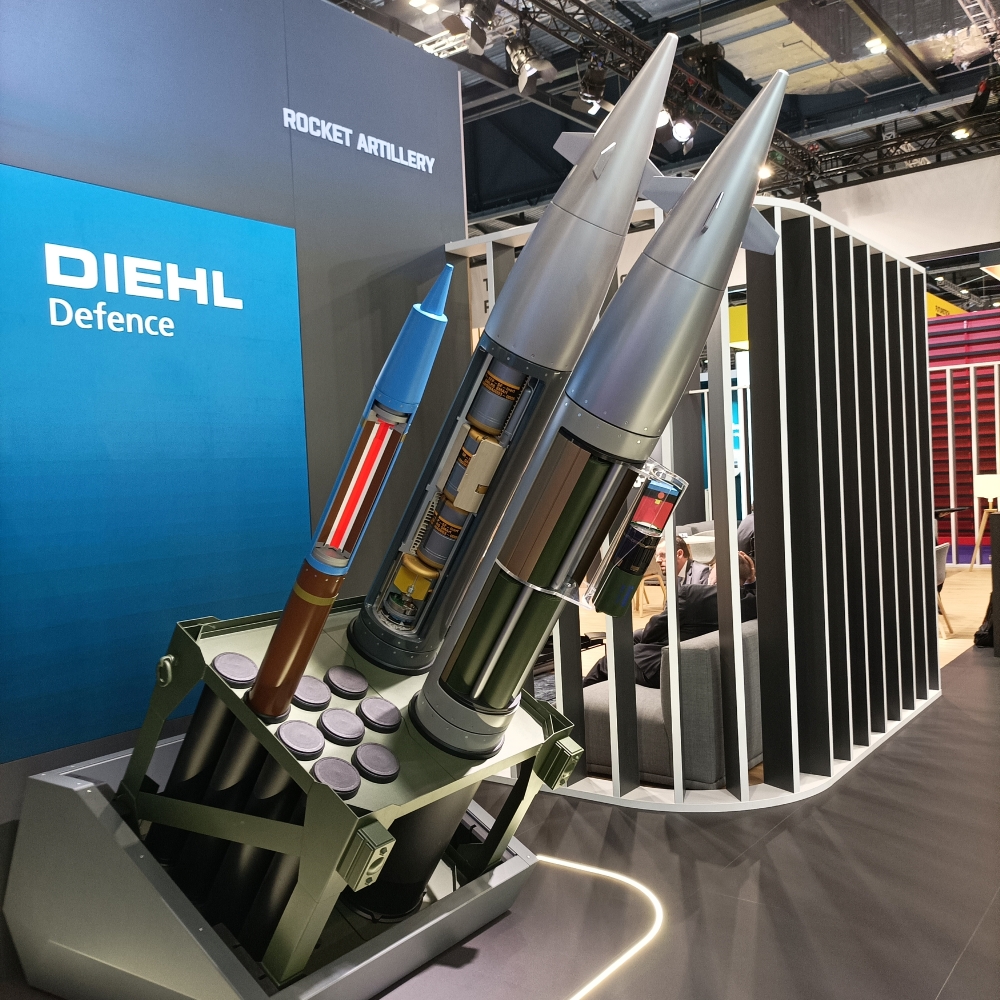
At DSEI, Diehl presented 2 advanced payload solutions for artillery rockets, specifically for the 306 mm EXTRA rocket, a product originally by the Israeli Elbit Systems, capable of reaching distances of 150 km.
The ‘Cargo SMART’ solution arms the EXTRA with 5 SMART guided, sensor-fused, top-attack anti-armour munitions that enable the destruction of enemy armoured vehicles on the move in a wide area.
Specifically, each of the 5 SMART sub-munitions has 3 independent sensors which are used to seek targets in a 35,000 square meters search area. The munition initiates its search pattern after being ejected from the carrier rocket and deploying a parachute system to retard its fall to the ground. The 3 sensors employed include active radar, also used as range measuring device, a passive radar measuring the reflections of space waves on the ground, and one infrared sensor for the final targeting. Once an enemy AFV has been acquired, the munition attacks from above with its Explosively-Formed Penetrator charge.
The SMART sub-munition is already known and operational in its 155 mm shell guise: the carrier shell contains 2 sub-munitions. Produced in the late 90s – early 2000s, the SMART 155 had actually gone out of production in the 2000s, following the completion of deliveries to Australia, Germany, Greece and Sweden for circa 12,000 shells overall. The UK had selected SMART 155 to replace the bomblet shells on the AS90 but the procurement plan was cancelled soon afterwards.
Production of the SMART 155 was re-started from 2017, spurred by the drastically mutated perception of the international situation.
Using sensor-fuzed projectiles with suitable self-destruction features to reduce Unexploded Ordnance concerns, the SMART is fully compliant with the terms of Oslo and Ottawa agreements against the use of sub-munitions.
The ‘Cargo AT-2’ rocket restores an anti-tank mine delivery capability that used to be available on MLRS. The EXTRA rocket is loaded with 30 AT-2 cylindrical, scatterable anti-tank mines originally developed by Dynamit Nobel.
Diehl deems the AT-2 to be compliant with sub-munitions treaty, but both UK and Italy, for example, which used to have scatterable AT-2 rockets for the M270 MLRS, elected to destroy their stockpiles in the early 2000s judging the scratch-wire fuze to be sensitive enough to risk activation by a person.
The AT-2 mines are scattered by the rocket and descend with parachutes in intelligent patterns: it is possible to pre-program the shape, density and orientation of the resulting surface-laid minefield. There are various options to time the activation of the AT-2s and their active period: they can remain in operation for as little as 2 or as many as 96 hours before self-destructing. They are, obviously, intended for the rapid laying of temporary barriers to constrain enemy movements.
Diehl also presented a solution for a training, reduced range rocket reaching between 7 and 15 Kms, with a spotting charge. This is based on the 122 mm ACCULAR rocket.
Given the political sensitivity around Israel at the moment, Diehl made no mention of Elbit and indicated that these solutions could be adapted to other rocket artillery solutions, but the EXTRA with its 306 mm calibre would not be an immediately transferable system onto HIMARS/M270.
The intended launcher is obviously PULS, which could employ up to 2 pods of 4 EXTRA rockets each. PULS had been gaining traction recently in Europe (Netherlands, Denmark, Germany, Spain) but Spain has just now decided to cancel the order in protest against Israel’s policy in Gaza.
Germany so far has only ordered an “exploratory” 5 PULS while it works out how to recapitalize its rocket artillery.








.png)
